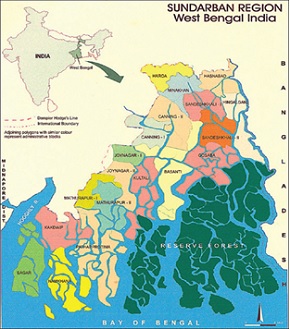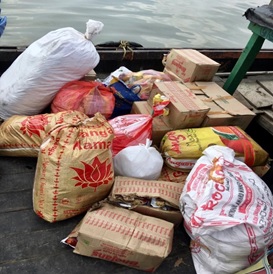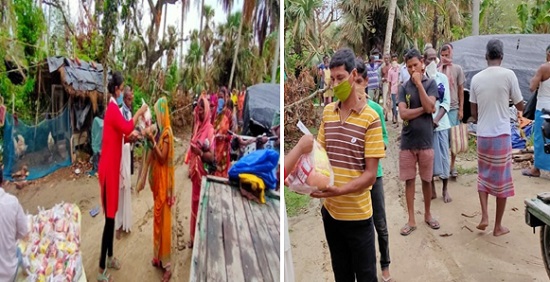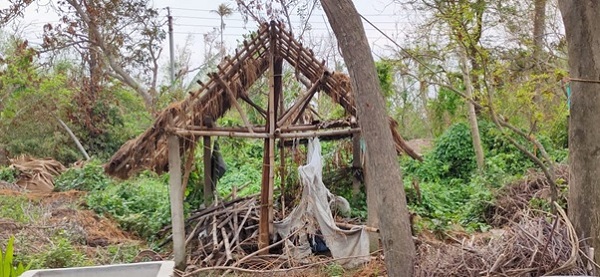Dec 25, 2025
Dec 25, 2025
by Rita Dey
The author witnesses how small non government organisations are helping the needy in Sunderbans after Amphan.
 The super cyclone Amphan hit West Bengal, India at the time while the whole country is reeling under COVID 19 and the return of migrant workers was creating further stress and tension to the economy of the State. Amphan devastated the Sunderbans and its ecosystem. The people were rendered land less, homeless, food less and almost overnight they became paupers. Like COVOD 19, Amphan spared none in the Sunderbans.
The super cyclone Amphan hit West Bengal, India at the time while the whole country is reeling under COVID 19 and the return of migrant workers was creating further stress and tension to the economy of the State. Amphan devastated the Sunderbans and its ecosystem. The people were rendered land less, homeless, food less and almost overnight they became paupers. Like COVOD 19, Amphan spared none in the Sunderbans.
The Indian Sundarbans is 4,200 sq. km. of reserved forests along with 5,400 sq. km. of non-forest area. The 58 inhabited and 48 forested islands are spread across of the North and South 24 Parganas in West Bengal. The largest estuarine mangrove forest is also the home to more than 200 tigers. Cyclones, rising sea levels and tidal waves have eroded landmass, depleted mangroves and the inundation of saline water is creating havoc on the agricultural lands. But now climate change is making the already fragile ecosystem even more vulnerable which is the home to at least 4.5 million people. They are mostly dependent on agriculture, fishing, tiger prawn seed collection, timber collection and honey collection. The locals have to travel miles to avail basic treatment at primary healthcare centers. Clearly, Amphan contributed to devastating their lives further.
 Aaboho, a small non government organisation made its way to help to help 110 families completely devastated by Amphan in a village called G Plot in Patharpratima Block located at the fringe of Sunderbans almost nose diving into Bay of Bengal. The approach to the village was difficult, more difficult was to avoid the goons who were masterminding the relief works from the mainland.
Aaboho, a small non government organisation made its way to help to help 110 families completely devastated by Amphan in a village called G Plot in Patharpratima Block located at the fringe of Sunderbans almost nose diving into Bay of Bengal. The approach to the village was difficult, more difficult was to avoid the goons who were masterminding the relief works from the mainland.
The roads and the bunds around the island village were in complete ruins. Dead fish, remnant of houses, beds, furniture, utensils, clothes, were floating in flood water all over. The villagers were stranded on small parcels of higher lands and on the wrecked roads.
There was fear of electrocution looming as electric wires ragged were seen all over the area. Boats were used to reach the village.

Aboho with its limited resources provided the villagers with dry food, medicines, milk, tents, tarpaulins, potable water, soap and clothes. It worked painstakingly through the local clubs and field level opinion leaders and based themselves in the villages to hand over the provisions directly. It has again begun collecting resources with more vigour to expand its reach and rehabilitate and resettle more villages in Patharpratima.

It reflects how, in West Bengal almost unknown small community based organisations like Aaboho, a grass roots group; Paschim Radhanagar Sundarban Jana Sramajibi Manch, a community organization works with fisher folk and the forest dependent people across the Sundarbans; and Sundarban Parjatan Pariseba Samabay Samity Ltd, a Cooperative Society Ltd) are striving to provide necessary relief to the people. These organisations run on small budgets with low overhead costs and move quickly to the disaster hit areas.
Any support to these organizations will go directly to the affected persons.
Aaboho: orpitaray@gmail.com;
Paschim Radhanagar Sundarban Jana Sramajibi Manch: sundarbanjanashramjibimanch@gmail.com
18-Jun-2020
More by : Rita Dey